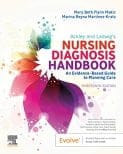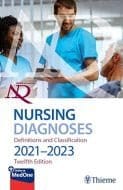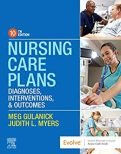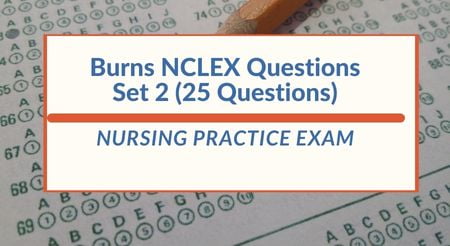Last updated on January 26th, 2024 at 05:27 pm
Burns NCLEX Questions Test Bank
Burns Nursing Diagnosis and Nursing Care Plans
Results
Last updated on January 26th, 2024 at 05:27 pm
Last updated on January 26th, 2024 at 05:27 pm
#1. A client with burns is receiving fluid resuscitation. The nurse notes crackles in the lungs upon auscultation. Which intervention should the nurse anticipate?
Administering supplemental oxygen is the appropriate intervention for a client with crackles in the lungs, as it improves oxygenation and helps resolve pulmonary edema.
#2. A client with burns has a temperature of 102.2°F (39°C), tachycardia, and confusion. Which complication should the nurse suspect?
Sepsis should be suspected in a client with fever, tachycardia, and confusion. Prompt intervention is necessary to prevent worsening sepsis and organ dysfunction.
#3. The nurse is caring for a client with circumferential burns to the extremities. Which assessment finding should be reported immediately?
The absence of pulses distal to the burn suggests compromised circulation and potential compartment syndrome, which requires immediate intervention to prevent tissue ischemia and necrosis.
#4. A client with burns is prescribed a topical corticosteroid cream. What is the primary purpose of this medication?
Topical corticosteroid cream is used to reduce inflammation and itching associated with burns, providing symptomatic relief.
#5. A client with burns is at risk for impaired mobility. Which intervention should the nurse implement to prevent contractures?
Assisting with range-of-motion exercises is crucial to prevent contractures and maintain joint mobility in clients with burns.
#6. A client with burns is prescribed a non-opioid analgesic. Which medication should the nurse anticipate administering?
Acetaminophen is a non-opioid analgesic commonly used for mild to moderate pain relief in clients with burns.
#7. The nurse is assessing a client with partial-thickness burns to the hands. Which finding requires immediate intervention?
Pale and cool fingertips suggest compromised circulation and require immediate intervention to prevent tissue ischemia and necrosis.
#8. A client with burns has a positive Tinel's sign upon assessment. What does this finding indicate?
A positive Tinel’s sign indicates possible damage to the underlying nerves and should be further investigated.
#9. A client with burns is prescribed gabapentin for neuropathic pain. Which instruction should the nurse provide to the client?
“Avoid driving or operating heavy machinery while taking this medication” is the appropriate instruction, as gabapentin can cause drowsiness and impair coordination.
#10. A client with burns is experiencing pruritus (itching) at the burn site. Which intervention should the nurse implement?
Administering an antihistamine medication is appropriate for relieving pruritus in clients with burns.
#11. A client with burns is being discharged with instructions for wound care. Which statement by the client indicates understanding of the instructions?
“I will wash my hands before and after dressing changes” indicates the client’s understanding of the importance of hand hygiene during wound care.
#12. A client with burns is at risk for impaired nutrition. Which intervention should the nurse prioritize to promote adequate nutrition?
Providing small, frequent meals helps promote adequate nutrition in clients with burns by reducing the metabolic demand and improving nutrient absorption.
#13. The nurse is caring for a client with full-thickness burns. Which finding requires immediate intervention?
A serum potassium level of 5.5 mEq/L suggests hyperkalemia, which can lead to cardiac dysrhythmias. It requires immediate intervention to prevent life-threatening complications.
#14. A client with burns is experiencing anxiety and fear. Which intervention should the nurse implement to address these psychological needs?
Encouraging the client to express feelings provides an opportunity for emotional release and therapeutic communication, helping address anxiety and fear.
#15. A client with burns asks the nurse about the risk of scarring. Which response by the nurse is appropriate?
“Scarring can be minimized with proper wound care” is an appropriate response, as proper wound care can help reduce the severity and extent of scarring in clients with burns.
#16. A client with burns is receiving a narcotic analgesic for pain management. Which intervention should the nurse implement to manage potential side effects?
Administering a stool softener as prescribed helps prevent constipation, a common side effect of narcotic analgesics.
#17. The nurse is caring for a client with full-thickness burns. Which finding requires immediate intervention?
A urine output of 30 mL/hr suggests inadequate renal perfusion and requires immediate intervention to prevent acute kidney injury.
#18. A client with burns is prescribed opioids for pain management. Which intervention should the nurse implement to minimize the risk of respiratory depression?
Monitoring oxygen saturation levels regularly helps detect early signs of respiratory depression in clients receiving opioids for pain management.
#19. A client with burns is scheduled for a skin grafting procedure. Which intervention should the nurse prioritize before the procedure?
Ensuring the client is well-hydrated is a priority intervention before a skin grafting procedure to optimize tissue perfusion and graft success.
#20. A client with burns is prescribed a nutritional supplement drink. Which intervention should the nurse implement to maximize nutritional intake?
Providing the nutritional supplement drink with each meal helps maximize nutritional intake and supports the client’s overall calorie and protein needs.
#21. A client with burns is at risk for impaired gas exchange. Which nursing intervention should be implemented to promote optimal oxygenation?
Providing humidified oxygen therapy helps optimize oxygenation by providing adequate moisture and maintaining airway patency in clients with burns.
#22. A client with burns is receiving wound care. Which action should the nurse take to minimize the risk of infection during dressing changes?
Applying sterile gloves before the procedure minimizes the risk of introducing microorganisms and helps maintain aseptic technique during dressing changes.
#23. A client with burns asks the nurse about the use of herbal remedies for wound healing. What is the appropriate response by the nurse?
“It’s best to consult with your healthcare provider before using herbal remedies” is an appropriate response, as herbal remedies can interact with medications and have varying effects on wound healing.
#24. A client with burns is experiencing sleep disturbances. Which intervention should the nurse implement to promote restful sleep?
Creating a quiet and dimly lit environment helps promote restful sleep by minimizing external stimuli and creating a soothing atmosphere.
#25. A client with burns is experiencing constipation. Which intervention should the nurse implement to promote bowel regularity?
Encouraging increased fluid intake helps promote bowel regularity and prevents constipation in clients with burns.

Best Nursing Books and Resources
These are the nursing books and resources that we recommend.
NurseStudy.net is a participant in the Amazon Services LLC Associates Program. Included below are affiliate links from Amazon at no additional cost from you. We may earn a small commission from your purchase. Please see our Privacy Policy

The Nursing Diagnosis Handbook E-Book: An Evidence-Based Guide to Planning Care
This is an excellent reference for nurses and nursing students. While it is a great resource for writing nursing care plans and nursing diagnoses, it also helps guide the nurse to match the nursing diagnosis to the patient assessment and diagnosis.
This handbook has been updated with NANDA-I approved Nursing Diagnoses that incorporates NOC and NIC taxonomies and evidenced based nursing interventions and much more.

NANDA International Nursing Diagnoses: Definitions & Classification, 2021-2023
All introductory chapters in this updated version of a ground-breaking text have been completely rewritten to give nurses the knowledge they require to appreciate assessment, its relationship to diagnosis and clinical reasoning, and the goal and use of taxonomic organization at the bedside.

Nursing Care Plans: Nursing Diagnosis and Intervention
It contains more than 200 care plans that adhere to the newest evidence-based recommendations.
Additionally, it distinguishes between nursing and collaborative approaches and highlights QSEN competencies.


